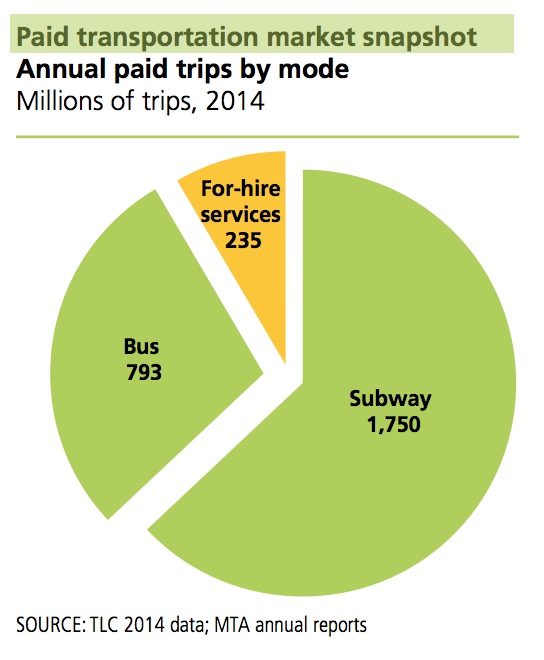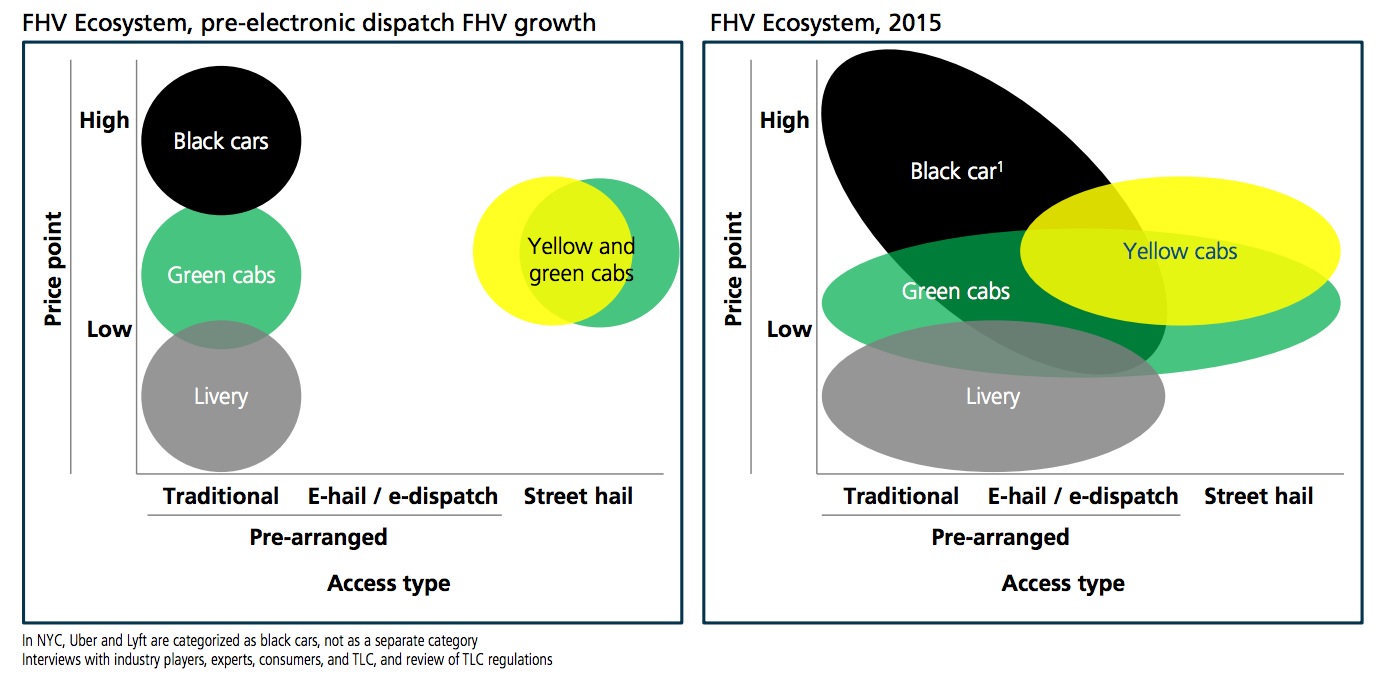CITY OF NEW YORK
OFFICE OF THE MAYOR, BILL DE BLASIO
In the last several years, the ubiquity of mobile phones, and the rise of new platforms for getting and giving rides have increased the complexity of New York’s transportation system. With the arrival and rapid growth of new types of on-demand for-hire vehicle services, the City has sought to answer fundamental questions about the potential impact of these changes on key priorities: managing the efficient movement of goods and services across the City, particularly in Manhattan’s congested Central Business District (CBD), supporting a comprehensive and sustainable transportation system, promoting equitable growth, and ensuring safety for drivers and passengers.
New York City is committed to offering a reliable, safe, accessible, and comprehensive transportation system that promotes the public good and meets the needs of all New Yorkers across all five boroughs. The City must make sure that residents and visitors have a range of appealing transportation options, that the streets are safe, that passengers are protected from fraud and abuse, and that those who work to provide transportation have fair and sustainable working conditions and income opportunities. While doing so, the City must take steps to ensure that its transportation system is accessible to all, regardless of individual ability.
For-Hire Vehicles are a Vital Part of New York City’s Transportation Mix
For-hire vehicles (FHVs) — yellow and green taxis, livery cars, traditional black car services, and the fast-growing app-based car services like Uber and Lyft — are an important part of the City’s transportation mix.
Although subway and bus trips significantly outnumber for-hire vehicle trips, for-hire vehicles provide some services that the mass transit system cannot. Many New Yorkers use for-hire vehicles when subway or bus lines are too far away from their home or destination or when mass transit is perceived as too slow or requires too long a wait. In addition to convenience and speed, passengers may also select for-hire vehicles for comfort, privacy, and the relative ease of transporting bulk items and packages.
Most New Yorkers get around using subways or buses. Public transit makes up the largest part of our transportation system by ridership, but taxi and livery services have long played a significant role. New York City has the lowest rate of private car ownership in the nation and the highest utilization of for-hire services. Every day hundreds of thousands of New Yorkers and tourists take trips in for-hire vehicles, relying on them to get to work, school, medical appointments, to and from the airports, and other destinations.
From the iconic yellow medallion taxis clustered in central Manhattan, to neighborhood car services found in communities across the Bronx, Brooklyn, Queens, and Staten Island, the industry has grown and changed to meet a wide range of customer needs. At the high end, there are limousines and premium black car services that largely work for corporate accounts. In the midrange value are yellow and green cabs, hailed on the street throughout the five boroughs. There are also small neighborhood livery companies, whose costs are often lowest and conduct many of their transactions in cash.
In the last three years, the landscape of for-hire service has changed considerably due to the rise of app-based electronic dispatch (or e-dispatch) services, such as Uber and Lyft, that allow customers to request vehicles on their smartphones.
The City’s Regulation of For-Hire Vehicles
The City regulates for-hire vehicle services through the Taxi and Limousine Commission (TLC) to promote the public interest. The rise of e-dispatch services have blurred the traditional line between medallion cabs, which can offer street-hail service, and non-taxi for-hire vehicles that offer pre-arranged service. With the quick arrival of a car at the tap of a button, the distinctions that yielded differential regulatory treatment across black and yellow cars are less relevant, and the City must adapt its traditional frameworks to support the new entrants that do not squarely fit into traditional categories. E-dispatch providers have worked with the TLC to meet requirements for existing categories, but their rapid growth has stressed the regulatory framework and is upending traditional categories, prompting the City to review the for-hire vehicle industry and lay out four priority areas for study and reform:
- Supporting a comprehensive transportation system (including the provision of transit choices, geographic coverage, accessibility, and the financial health of the system as a whole);
- Promoting equitable growth (including consumer protections around pricing and other issues, labor market impact and job quality);
- Managing mobility impacts in the Central Business District of Manhattan (assessing the ability of people and goods to travel into, out of, and around Manhattan, the volume of vehicle traffic on the roads, the capacity of the roads themselves, and assessing any environmental impact); and
- Ensuring safety (for drivers, passengers, and other users of New York City streets).
In the FHV industry, as in other economic sectors, when sudden changes in market activity produce outcomes that might be counter to the public interest, government must evaluate the rapid changes and take strategic steps to promote a vibrant marketplace while crafting reasonable regulations to promote the public good. In this report, we set forth facts and findings that provide a basis for the future regulation of New York City’s for-hire vehicle market.
This report is a product of months of analysis and evaluation, drawing upon the City’s internal agency expertise, along with the assistance of outside consultants, to provide the fact basis on the current baseline conditions in the Manhattan core. Data provided in this report was collected during the study period (August through October, 2015).
Download full version (PDF): For-Hire Vehicle Transportation Study
Tags: Bill DeBlasio, City of New York, FHV, For-Hire Vehicles, Lyft, New York City, NYC, Taxi, Uber








 RSS Feed
RSS Feed